Pearloid 101- how to choose the perfect pearl material for your next favourite scratchplate
Pearloid is a classic scratchplate material, seen on a whole host of guitars over the years. One in particular, white, is EXTREMELY commonly seen, but we thought it’d be useful to give some background on what our ‘4ply Celluloid Pearl’ sheet materials involved.
Firstly, is pearl material made from pearls?
Nope.
Is it made from mother-of-pearl?
No.
Are pearloid materials exclusively licensed by 90’s alt-rock superstars Pearl Jam?
Not as far as we know, but we’re still waiting for Eddie Vedder to return our calls.
So what is is then?
First developed in the 1940s and 1950s, pearloid is a synthetic alternative to actual mother-of-pearl, or abalone. Unlike the real stuff, it’s really easy to work with and is theoretically vegan (unless you count all the dead dinosaurs required for plastic production…). Most folks saw this for the first time when the Fender Mustang was launched in 1964; the student model’s red and blue versions featuring a 4ply pearl white pickguard.
The pearloid layer of this material is made using the same process as our celluloid red tort material- by swirling together different chemicals in a big vat to create a non-repeating pattern. This is then solidified, and sliced super thin! The factory then adds this layer between a 3ply ABS material (basically the same as our 3ply white) and a clear layer on top.
This stuff looks fantastic under stage lighting, as it reflects light in all directions- similar to our glitter material, but a lot more traditional.
Let’s dive into the different colours available! When you’re ready to order, simply follow THIS LINK
White Pearl
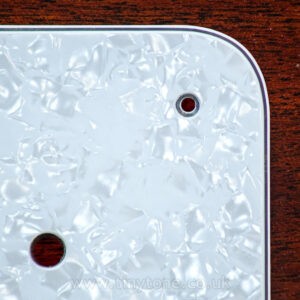
The original! This is the classic pearl pickguard material. Works well with most body finishes so long as they aren’t too busy- however if your guitar has a natural body with an interesting grain, choosing this option can make the pickguard look cheap and the body look boring… a bit like wearing black with colour (or so we’re told…). If in doubt though, then either this, black, or ivory pearl will do the trick!



Mint Pearl
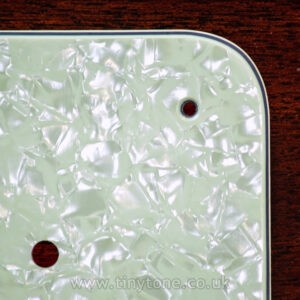
This one isn’t for everyone, so be careful it doesn’t clash with your guitar! Can look really nice on certain finishes however- shell pink, or sonic blue for example. Choose it wisely!


Ivory Pearl

This is our favourite pearl sheet material, and it seems that you guys agree- it’s easily our bestselling pearloid material!
Why does it sell so well?
Well, it gives the appearance of regular white pearl but which has aged a little in the sun, so it looks like a vintage pickguard, and by extension can prevent your guitar looking a bit too shiny and new… generally, older and more worn-in guitars look a little better, and the toned-down white of this sheet just seems to go with almost any finish we can think of. If you already have a white pearl scratchplate, consider the upgrade. If you’re in doubt about which pearl material to go for, choose this one. It’s simply that good.
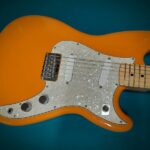

Cream Pearl
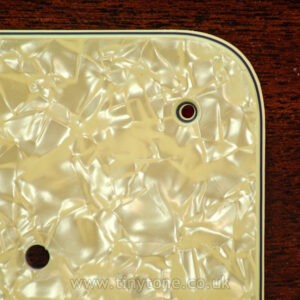
If Ivory Pearl is White Pearl that spent too long in the sun, Cream Pearl is well and truly roasted. This is a lovely creamy colour and goes really well on guitars with cream hardware or binding- we often make these for Les Paul, Gretsch, Hofner, and Jazzmaster guitars. Looks great next to blue, bright pink, green, or sunburst finishes.

Pearl Yellow
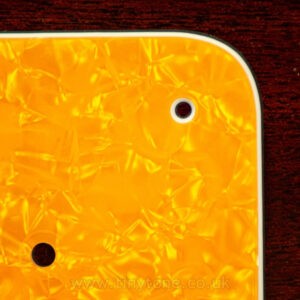
We’re now moving on to the more ‘distinctive’ materials on our list. This yellow, likened to egg yolk (or the LA Lakers‘ logo) is a bit on the aggressive side, but looks awesome on the right guitar.


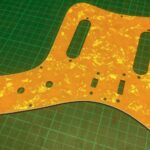
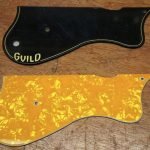
Burnt Orange
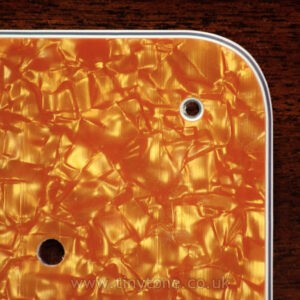
A little more restrained than the yellow material above, this burnt orange is distinctive, and once again looks lovely on the right guitars… but downright awful on the wrong ones.
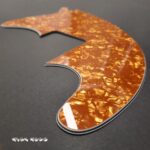

Bronze Pearl
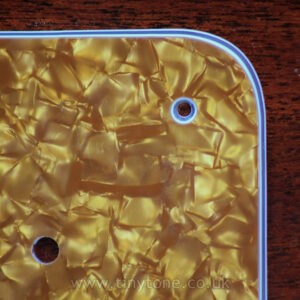
This one was sometimes seen on classic archtop ‘jazzbox’ guitars in the 1940s, a particularly early iteration of pearloid. Looks great on certain archtops, but also goes well with orange bodies.

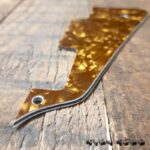
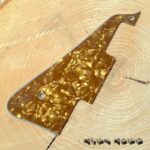
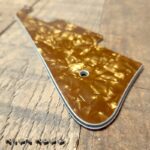
Red Pearl
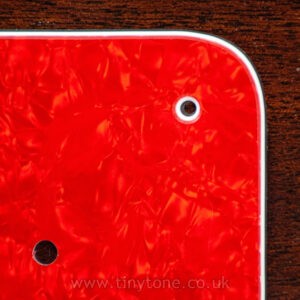
Red pearl looks FANTASTIC on black guitars, especially those with maple necks- remember the Squier Pete Wentz Precision Bass? Say no more.
(best of luck to the absolute chancer trying to sell theirs for £3000 on eBay currently… these still routinely sell for sub-£25o-ish)
Also looks great on white, blue, and green bodies where you want the guard to really pop!

Pink Pearl
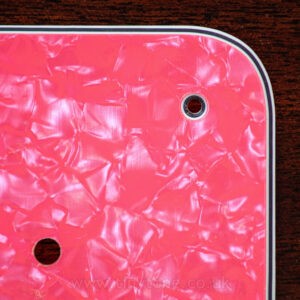
Not just for girls, this Barbie pink is an absolute statement for anyone who wants to stand out!! Looks great on black, white, and purple guitars.

Light Purple Pearl
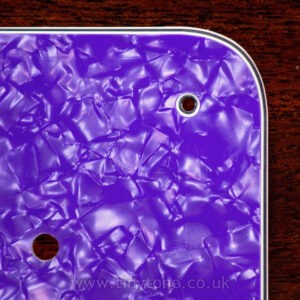
Our purple comes in two shades- light and regular. This light one, once again, looks fantastic on the right guitar, but can look ultra-garish if you’re not careful. Personally, as with all of these louder colours, we find it works best on plainer looking bodies- black and white are safe bets, otherwise for bodies with complimentary tones on the colour wheel.
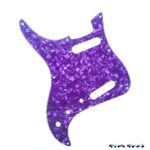
This one is a Left Handed Washburn Force 3 We’ve made bespoke

This one is a Left Handed Washburn Force 3 We’ve made bespoke
Purple Pearl
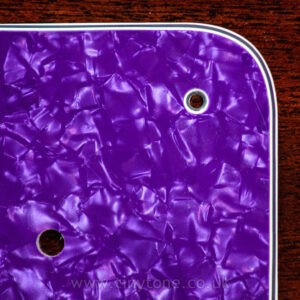
This regular purple, once again, looks fantastic on the right guitar, but can look ultra-garish if you’re not careful. Personally, as with all of these louder colours, we find it works best on plainer looking bodies- black and white are safe bets, otherwise for bodies with complimentary tones on the colour wheel.
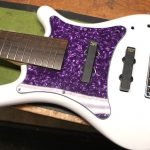

Violet Pearl

Not quite purple, this violet pearl is almost grey in tint… I’d recommend it be paired with a black body, but each to their own!
This is a bit of a rare seller, so we’ve no sample images currently.
Here’s a link to the 1996 Space Jam website instead.
Light Blue Pearl

Blue comes in three shades- light, regular, and ocean. This light one, once again, looks fantastic on the right guitar, but can look ultra-garish if you’re not careful. Personally, as with all of these louder colours, we find it works best on plainer looking bodies- black and white are safe bets, otherwise for bodies with complimentary tones on the colour wheel.
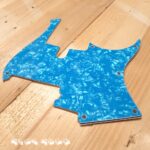

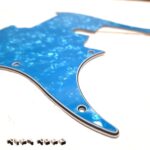
Blue Pearl

This regular blue, once again, looks fantastic on the right guitar, but can look ultra-garish if you’re not careful. Personally, as with all of these louder colours, we find it works best on plainer looking bodies- black and white are safe bets, otherwise for bodies with complimentary tones on the colour wheel.

Ocean Blue

This is a super light blue, supposedly ‘ocean’ coloured… but after three years spent travelling the world as a guest entertainer on cruise ships, I can hand-on-heart say I never saw an ocean this colour, even in the South Pacific.
Once again though, on the right guitar, it’ll look great. Personally I’d pair it with a white body.

Grey Pearl

I have to be honest, grey pearl is my least favourite material. But luckily, taste is subjective, so you might love it! Certain deluxe Fender basses used to come with grey pearl guards, and I could see what they were getting at- if you think it works, don’t let me opinion stop you!
Sadly no sample images of this one yet sorry!
Here is a link to some internet silliness involving cats instead.
Black Pearl
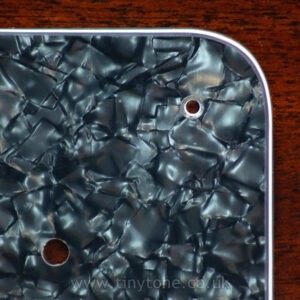
Black pearl is super useful- it goes with almost everything!! Think of it as white pearl’s evil twin. The pearloid texture itself can be a little busy for some guitars, but generally, this will look good on most instruments, just like white pearl.


Green Pearl
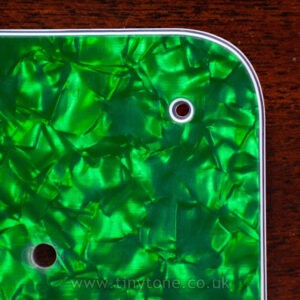
Green pearl! This one’s a bit nuts, but weirdly it goes with more stuff than you’d expect. Personally, I quite like this one on sunburst guitars, but I’ve seen folk use it on shell pink instruments to devastating effect. Use with caution.


Cola Pearl

When we say cola here, we don’t mean the guys that turned Santa red- we refer to Cola Cubes, the British sweet shop classic. Folks of a certain age will remember spending pocket money on a small paper bag of these at the local newsagent. I digress though- best you have a look at the images to understand the colour. Once again… looks great on the right guitar!


Tiger Pearl

I’d love to talk in detail about how awesome this tiger pearl material was… but sadly there’s little point- emphasis on the ‘was’ before. Sadly, this material has been hunted to extinction. It used to be popular with Prince fans, but sadly the supplier stopped importing it in 2020 and we’ve not been able to reliably source it since. Don’t worry however- Leopard Pearl is still available, and it’s hunting season!

Leopard Pearl

Leopard Pearl is the king of all scratchplate materials, never mind the pearl ones. You may not like it, but this is what peak performance looks like. These are facts, and you can’t deny them.
…well, ok, perhaps this isn’t for everyone or every guitar. It’s pretty damn loud, even by our standards. But I adore this material. It’s actually 4ply white pearl, but with an additional printed leopard print layer on the top. Under stage lighting this stuff looks fantastic, and it goes down a treat onstage with my function bands- high energy scratchplates to match high energy bands and high energy music!
I’ve got this on a couple of my personal instruments; a Geddy Lee Jazz Bass and a Kala Solid Body U-Bass. It may not float your particular boat, but hopefully you can see that the material does suit the instruments really well!
The only snag with this stuff is that the leopard layer is printed, with a seam halfway along the material- on a 300×450 sheet, this means that unless your pickguard is 300x225mm or smaller, there will be a line where the pattern repeats on one corner of your guard. But personally I’d say that’s worth it.





So there you have it! A good look at all of the different pearl materials we offer, as well as an overview on the history and manufacture of it. Hopefully this has been of some use to you! And of course if you’re ready to give your guitar a serious upgrade, here’s a link to make it happen!





